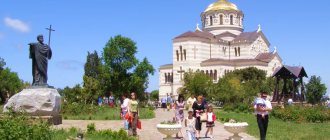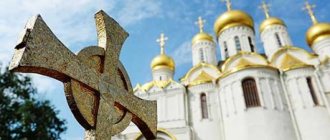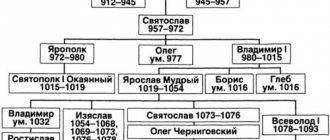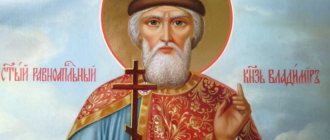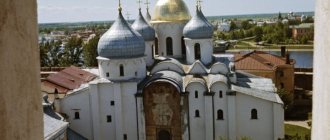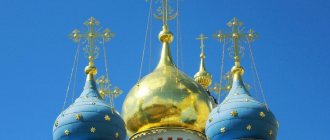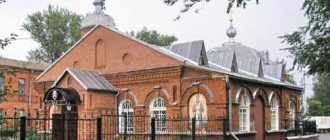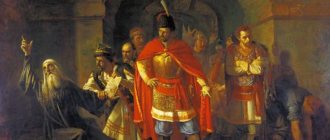| Vladimir, view of the Assumption Cathedral. Photo of the website of the Pilgrimage Service of the Vladimir Diocese vladpalomnik.ru |
Vladimir
(other names
Vladimir-on-Klyazma, Vladimir-Zalessky
), a city in Russia, the administrative center of the Vladimir region, the cathedral city of the Vladimir diocese. The ancient capital of North-Eastern Rus'. Located primarily on the left bank of the Klyazma River, 176 km east of Moscow. Population 345.6 thousand (2010).
- On the map: Yandex.Map, Google map
The date of the initial settlement of people on the site of the city of Vladimir has not been established.
It is known that the Slavs appeared here at the beginning of the century. Before their arrival, the indigenous population were Finno-Ugric tribes. Based on archaeological finds, it can be argued that on the site of the current city, from ancient times there was a settlement of the aborigines of the Suzdal land - the Meryans, and their distant ancestors lived here long before the birth of Christ. In 990 or 992, the Kiev Equal-to-the-Apostles Prince Vladimir Svyatoslavich founded a city on the site of an ancient settlement, which was first mentioned in chronicles in connection with the baptism of its people. The Addendum to the Hypatiiv Chronicle [1] states:
“in the summer of 6498 (990), Volodimer went to the land of Slovenia and the country of Zalesskaya, to the Suzdal region and to Rostov, and built a city there over the Klyazma River, and called it by his first name Volodimir, and created the cathedral church of the Most Holy Theotokos: commanded baptize people everywhere and build churches, and give them the first bishop, Theodore.”
In the first half of the 12th century, feudal Kievan Rus began to disintegrate into independent lands, in which local, princely dynasties established themselves. Between them, brutal civil wars began. Under these conditions, the importance of North-Eastern Rus' is growing. The city of Vladimir occupied a convenient geographical position; it was located on the high, steep bank of the Klyazma, close to the confluence of the Nerl, Rpen and Lybid rivers. Consequently, the city had strong natural fortifications and occupied a location convenient for trade. All this attracted the attention of Prince Vladimir Monomakh, who founded a wooden fortress here around 1108 and surrounded it with an earthen rampart [2].
Capital of Rus'
In 1157, after the capture of Kyiv, Prince Andrei Bogolyubsky moved the capital of Rus' to Vladimir, which led to the rise and prosperity of the city. Andrei Bogolyubsky significantly expanded the defensive lines of the city and richly rebuilt it. The prince protects with high ramparts the eastern, suburban part of the city and the western, princely part.
White stone construction is expanding widely in Vladimir. In 1158, on the site of the ancient wooden Church of the Assumption of the Blessed Virgin Mary, construction began on the white-stone Assumption Cathedral. According to the prince’s plan, it was built not only as a temple for the Vladimir principality, but also as the main temple of all Rus', so the cathedral was supposed to outshine in splendor all the temples that existed before in Rus'. And although in size it was inferior to both Kyiv Sofia and Novgorod, it surpassed them in height. Other remarkable buildings of that time were the beautiful Church of the Intercession on the Nerl and the wonderful palace ensemble in Bogolyubovo. A new princely palace was built in Vladimir itself.
For the further rise of the new capital, Prince Andrei wanted to move the metropolitan see to Vladimir. This caused strong indignation among the nobility and clergy. This plan was not realized, although some Rostov bishops lived in Vladimir from time to time; the actual foundation of the independent Vladimir See dates back to approximately 1214.
In 1174, Andrei Bogolyubsky was killed as a result of a boyar conspiracy, which gave rise to civil strife that weakened the city.
In 1176, Vsevolod the Big Nest became Prince of Vladimir, under whom the city reached its greatest prosperity.
In 1197, the majestic Demetrius Cathedral was built, one of the remarkable structures of Vladimir-Suzdal architecture. In 1185, the Assumption Cathedral was restored after a fire and expanded with the addition of new walls, in 1191 the Nativity Monastery was founded, another white-stone cathedral was built in it, and in 1201 the women's Princess Assumption Monastery. The majestic buildings in Vladimir became models for the construction of other cities of Rus'.
In 1238, after a siege and stubborn resistance, Vladimir was taken by the Mongol-Tatar hordes of Batu. All that remains of the magnificent city of Vladimir, richly decorated with buildings, is the ashes and charred walls of the mighty stone structures of the Assumption and Demetrius Cathedrals, the Golden Gate and several churches.
After the invasion of Khan Batu, the Golden Horde prince Nevryu invaded Vladimir-Suzdal Rus'. In 1252 he ravaged the lands along the Klyazma. And just three decades later, in 1281-1282, a new invasion followed. This time, at the head of the army that came from the horde were the princes Kovgady and Algidai. The enemy did not dare to go to Vladimir, where it was necessary to overcome a strong defensive system, and limited itself to devastation of the outskirts of the city.
The most devastating invasion after Batu into the lands of northwestern Rus' was the invasion in 1293 of the so-called Duden Army. The Mongol-Tatar army led by Tudan (Dyuden) destroyed and plundered fourteen cities. Vladimir was among them. In total, in the 13th century, Vladimir was defeated twice and its surroundings were devastated three times. Nevertheless, Vladimir remained the main city of Rus'.
In 1299, the department of the Kyiv Metropolis was transferred to Vladimir. For a long time (before the Trinity-Sergius Lavra) the Vladimir Nativity Monastery was the main monastery of Rus'.
The rise of Moscow and the loss of Vladimir's importance
Repeatedly ruined, Vladimir alone was never able to return to its former greatness. It remained only the nominal capital of Rus'. The princes, having received the label for the great reign, remained in their estates, acquiring primacy over other princes and the right to collect tribute for the horde. Moscow, Suzdal, Tver, and Nizhny Novgorod princes are fighting for the Vladimir table.
In the 14th century, the greatness of Moscow increased. The Moscow princes, receiving the Grand Duke's throne of Vladimir, remain in Moscow. At St. Peter in 1325 the metropolitan see was transferred from Vladimir to Moscow.
In the fall of 1382, Vladimir suffered from the troops of Khan Tokhtamysh, who plundered the northeastern part of the country.
In 1395, Vladimir lost its main shrine - the Vladimir Icon of the Mother of God, which was transferred to Moscow, and the residents of Vladimir received from Moscow a copy of it, written by Metropolitan Peter.
In 1411 (1441?) the city was attacked by the Tatar prince Talych and the Nizhny Novgorod governor Karamyshev, Vladimir was plundered and burned.
In 1521, the city of Vladimir was again ravaged by the Kazan and Crimean Tatars under the leadership of Khan Magmet-Girey; the attack was brutal, but it was the last.
With the growth of the Moscow state, Vladimir moves into the category of an ordinary provincial city. Although in the title list of Russian princes and tsars he was still placed in first place, ahead of Moscow.
Time of Troubles
During the time of troubles, the interventionists, the troops of the Polish gentry and the Lithuanians, from April 2 to 6, 1609, tried to take possession of Vladimir, the Lithuanian troops and the Russian mercenaries of the governor Pleshcheev, but to no avail. The fortress stood firm and did not open its Golden Gate to the enemies. Having failed to achieve success, they left.
During the interregnum, the people of Vladimir kissed the cross in fidelity to Prince Vladislav, if he converted to Orthodoxy. But when it was discovered that Prince Vladislav would not be the Russian Tsar, but instead King Sigismund III, an ardent fanatic of Catholicism, wanted to take the Russian throne, the people of Vladimir decided to stand against the Polish and Lithuanian people with other cities. Lisovsky's gangs, which roamed Russia even after the election of Mikhail Fedorovich to the kingdom, attacked Vladimir already in 1614, and again without success. Vladimir has always been one of the central gathering points of the people's militia against the invaders; the commander of the militia army, Prince Dmitry Pozharsky, himself came from Vladimir.
Vladimir in the era of the Russian Empire
Inventories of the city of Vladimir from the 17th century and the beginning of the 18th century that have survived to this day indicate that the city was then very poor and sparsely populated. So in 1626 there were only 340 people fit for military service in Vladimir, of which 128 were townspeople, 62 were house servants, 50 were peasants; 10 years later, in 1635, the population increased slightly: there were already 184 townspeople, 100 courtyard people. Judging by the inventory, the city retained its ancient structure and was still divided into three parts: the Kremlin or non-black city, the earthen city, and the dilapidated city.
The terrible fire on October 1, 1719, which burned down 11 churches, the Gostiny Dvor, the zemstvo hut and 79 townsman and tax yards, delayed the development of the city for a long time.
Since 1719, Vladimir has been the center of the province of the Moscow province.
In March 1778, the Vladimir province was formed.
Modern times
Vladimir entered the century as a provincial town. In 1914, 47 thousand people lived in it. And although half of Russia’s industrial enterprises were concentrated in the Moscow, St. Petersburg and Vladimir provinces, only about 500 workers were employed in the city itself and mainly only handicraft production and trade developed. The largest enterprise in the city was a candle factory.
By the end of the 1920s, illiteracy had been largely eliminated and industrial development began. Factories built in the 30s "Avtopribor" and "Himplas Joy of All Who Sorrow" icons of the Mother of God, prison church
Educational establishments
- Vladimir Theological Seminary
Vladimir-Suzdal Museum-Reserve
Vladimir-Suzdal Museum-Reserve
Vladimir
The Vladimir-Suzdal Museum-Reserve introduces the monuments of ancient Russian architecture located in Vladimir, Suzdal, Gus-Khrustalny, Bogolyubovo, Kideksha and Muromtsevo. Among the most valuable objects are monuments of white-stone architecture of the 12th–13th centuries: the Assumption Cathedral, the Golden Gate, Demetrius Cathedral, the Suzdal Kremlin and others.
The branches of the museum-reserve in Vladimir contain unique exhibits. In the Historical Museum there is a church chasuble made from the velvet fur coat of Prince Dmitry Pozharsky, in the Trinity Church there are creations by masters of glass, artistic embroidery and lacquer miniatures, and in the “Chambers” museum complex there are paintings by Ivan Aivazovsky and Alexei Savrasov.
City information
Vladimir is the administrative center of the region of the same name. Located in the west of the Russian Federation. Located on the banks of the Klyazma River. The economy is represented by enterprises of the chemical, food industry, mechanical engineering, energy, and metallurgy. They form a large industrial center.
The M7 Volga highway passes near the settlement. The Trans-Siberian Railway runs through. The airport is located for cargo delivery. There are secondary specialized and vocational educational institutions, universities and their branches. The population is more than 350 thousand people.
Cathedral of the Assumption of the Blessed Virgin Mary
Cathedral of the Assumption of the Blessed Virgin Mary (Theotokos Cathedral…
Vladimir region
The first stone building of the Assumption Cathedral was built in 1160 by the decision of Prince Andrei Bogolyubsky. In 1185, the cathedral was damaged by fire - then it was significantly rebuilt by the masters of Prince Vsevolod the Big Nest. In the 15th century, the temple building became a model for the construction of the Assumption Cathedral of the Moscow Kremlin.
In the Assumption Cathedral, a large composition of “The Last Judgment” of 1408, painted by Andrei Rublev and Daniil Cherny, has been preserved. Here are the most valuable frescoes - “Abraham’s Bosom”, fragments of “The Descent of the Holy Spirit”, “Baptism”, “Transfiguration” and other famous images.
Princes
At the Lyubechsky Congress of Princes, it was decided that the Rostov-Suzdal land (as the principality was originally called) was transferred to the management of the family of Vladimir Monomakh. Therefore, Yuri Dolgoruky, the son of Monomakh, became the first prince here.
Full list of princes:
- Yuri Dolgoruky (reigned 1125-1155)
- Andrey Bogolyubsky (1157-1174)
- Vsevolod the Big Nest (1176 - 1212)
- Yuri Vsevolodovich (1218 - 1238)
- Yaroslav Vsevolodovich (1238-1246)
- Alexander Nevsky (since 1252).
It is enough to look at the list to understand that these were the people who enjoyed the greatest influence in Rus'. The Vladimir-Suzdal princes mainly pursued the goal of independence from Kyiv and the subordination of other principalities to their power.
Golden Gate
Golden Gate
Vladimir
The Golden Gate is a rare example of an ancient Russian defensive structure. The gate was built as the main military and passage building of the city fortress, which was erected in Vladimir by Prince Andrei Bogolyubsky in the middle of the 12th century. The Golden Gate was a powerful tower with a 14-meter arch. Above the vault there was a battle platform, and in the upper part of the tower there was a miniature white stone Temple of the Deposition of the Robe.
Despite fires and enemy raids, the appearance of the Golden Gate remained unchanged until the beginning of the 19th century. Then the building was seriously rebuilt, and the gate church was rededicated. Today, the historical building houses a branch of the Vladimir-Suzdal Museum-Reserve. Here is a diorama depicting the assault on Vladimir by the troops of Khan Batu, a gallery of “Heroes of Vladimir” and other exhibitions.
Peculiarities
The political features of the Vladimir-Suzdal principality consisted in the strong power of the prince. Unlike most other lands, here the prince was the head and decided all important issues. Schematically, the political features of a given land can be represented as follows.
The strong power of the prince was possible due to the fact that in these lands there were a large number of new cities, where a strong boyars had not yet formed. As a result, only the prince had real power, and the Veche was only advisory in nature.
In general, the features of the development of the principality in the appanage period (12-13 centuries) are as follows:
- Unlimited princely power.
- Population increase. People moved to these lands because they were relatively safe from raids by nomads.
- Agriculture was actively developing in the principality. There were many forests that served as natural protection.
- Rapid growth of cities. This applies both to new cities built during this period (Moscow, Pereyaslavl-Zalessky and others) and to old cities (Vladimir, Suzdal, Rostov, Yaroslavl and others).
- Geographical location at the intersection of important trade routes along the Volga and Oka.
Economic features
Despite its geographical location, the Vladimir-Suzdal land had a large amount of arable land, which made agriculture a key aspect of the economic development of the region. Other industries also actively developed in these lands: fishing, hunting, beekeeping.
The resettlement of people from the south played a great influence on the economic development of the principality. They not only moved, but also carried elements of culture with them. Many of them were artisans, as a result of which the craft in the Vladimir-Suzdal land began to develop very quickly.
Cathedral of Demetrius of Thessalonica
Cathedral of Demetrius of Thessalonica in Vladimir
Vladimir region
Demetrius Cathedral at the princely court was erected in 1194 by Vsevolod the Big Nest. The temple was consecrated in honor of the Great Martyr Demetrius of Thessalonica. Russian architects, as well as Greek, German and Italian masters, worked on the construction of the cathedral. Demetrius Cathedral is famous for its white stone carvings: the walls of the temple are decorated with about 600 reliefs with images of saints, animals and plants.
Today the Cathedral of Demetrius of Thessalonica is a branch of the Vladimir-Suzdal Museum-Reserve. The main exhibit of the museum is the ancient temple building itself with its interior decoration. Fragments of frescoes from the 12th century have been preserved here, including the composition “The Last Judgment.”
The city of Vladimir is the ancient capital of North-Eastern Rus'.
Published by: Lena 12/09/2012 in Uncategorized, Trips with children, Travel |
Vladimir is a historical city in Russia, located primarily on the left bank of the Klyazma River. It was the ancient capital of North-Eastern Rus'.
The first people began to appear on the territory occupied by the modern city around 30-25 thousand years BC. e. In the third millennium BC. e. Volga-Finnish tribes live here. In the VI-VII centuries AD. e. This territory is being developed by the Finno-Ugric tribe Merya.
In the 9th-10th centuries, first the Ilmen Slovenes, and then other tribes, began to penetrate here. In the 8th-10th centuries, on the hill where the Assumption Cathedral was later built, there was a Meryan village.
The founding of Vladimir is traditionally associated with the chronicle news that Vladimir Monomakh founded the city in 1108. The most prominent specialist in Vladimir archeology, N.N. Voronin, also adhered to this dating.
But in the 1990s, Vladimir local historians spoke out in favor of moving the date of the city’s founding to 990, citing in support of this date the news of a number of later chronicle sources, where Vladimir Svyatoslavich appears as the founder of the city.
Whenever the city was founded, Vladimir began to grow and strengthen thanks to the care of Vladimir Monomakh, who strengthened it as a stronghold for the defense of the Rostov-Suzdal Principality.
The city owes its prosperity to Prince Andrei Bogolyubsky, who in 1157 moved the capital of the principality here. His successor, Vsevolod the Big Nest, was one of the most powerful Russian princes, and from his reign the title of “great” was assigned to the Vladimir princes.
In Vladimir and neighboring Suzdal, the Vladimir-Suzdal school of painting developed; chronicles were being written in the city.
Vladimir was struck in 1238 by the Mongol-Tatar invasion. Later, the city was subjected to Tatar raids several times, the heaviest of which was the destruction of Duden’s army in 1293.
Starting with Vasily Yaroslavich, in the conditions of increasing fragmentation in North-Eastern Rus', Vladimir ceased to be the residence of the great princes, who now only performed the rite of enthronement there, remaining to live in their hereditary lands. However, it was the Vladimir princes who were recognized in the Horde as the oldest in all of Rus', thanks to which Vladimir became the nominal capital of the Russian lands. This status was further strengthened in 1299, when the city became the residence of Russian metropolitans.
As the main table of North-Eastern Rus', Vladimir did not have his own princely dynasty. Control over it, along with a vast domain territory, was received by one of the appanage princes using the khan's label issued in the Horde. During the 1st half of the 14th century, the main contenders for the great reign were Tver, Moscow and Suzdal. An important milestone was the move in 1325 from Vladimir to Moscow (under Ivan Kalita) of Metropolitan Peter. Dmitry Donskoy managed to achieve recognition of hereditary rights to Vladimir by all neighboring princes and the Horde, which meant the merger of the Moscow and Vladimir principalities.
In 1382, Vladimir, like other cities of North-Eastern Rus', suffered from the invasion of Tokhtamysh.
In 1408, Vladimir was devastated by the Tatars and Nizhny Novgorod residents.
In 1441, the city was attacked by the Tatar prince Talych and the Nizhny Novgorod governor Karamyshev.
With the growth of the Moscow state, Vladimir became an ordinary provincial city. Although in the title list of Russian princes and tsars he was still placed in first place, ahead of Moscow.
It is known that in 1609 the people of Vladimir rebelled against the protege of False Dmitry II, governor Velyaminov, throwing stones at him.
In 1614, the outskirts of the city were devastated by the troops of the Polish adventurer Lisovsky.
Since 1719, Vladimir has been the center of the province of the Moscow province.
Some economic and cultural growth of Vladimir began at the end of the 18th century, when it became the administrative center of the governorship (1778), and from 1796 - the Vladimir province. According to the regular development plan for Vladimir approved in 1781, the construction of large stone public and residential buildings began.
In 1838-1840, A. I. Herzen served exile in Vladimir. The infamous “Vladimirka” passed through the city - the Vladimirsky highway, which was used to send convicts convicted on foot to hard labor to Siberia.
In 1861, traffic was opened along the Moscow-Vladimir line of the Moscow-Nizhny Novgorod Railway.
In December 1858, a telegraph began operating in the city, the construction of a water supply system was completed in 1866, telephone communications appeared in 1887, and the first power plant began operating in 1908.
After the establishment of Soviet power, many streets in Vladimir were renamed, most parish churches were closed and sentenced to demolition, and some cemeteries within the city were destroyed.
At the same time, the industrialization of Vladimir is associated with the first decades of Soviet power.
During the Second World War, about 25,000 people were drafted from Vladimir, including about one and a half thousand women. Almost half of them did not return. On August 14, 1944, Vladimir becomes the center of the region.
In 1958, the Vladimir-Suzdal Historical, Architectural and Art Museum Reserve was created, which includes a group of unique architectural monuments of Russian defensive and church architecture, located in three cities - Vladimir, Suzdal and Gus-Khrustalny, as well as the villages of Bogolyubovo and Kideksha.
Now Vladimir is one of the largest tourist centers in the country and is part of the Golden Ring of Russia. The monuments of the pre-Mongol era preserved in it are of greatest interest.
Two such monuments can be seen at once on Cathedral Square:
The first is the Cathedral of the Assumption of the Blessed Virgin Mary, also known as the Assumption Cathedral in Vladimir-Volynsky, also known as the Mstislav Church in Vladimir-Volynsky, also known as the Holy Dormition Cathedral in Vladimir-Volynsky - the oldest and only monument in Volyn that has come down to us from the times of Kievan Rus .
It was built and painted in 1160 under the Volyn prince Mstislav Izyaslavich by Kyiv builders.
The cathedral was the tomb of princes, boyars and bishops. Under the temple there are 6 grand ducal, 2 episcopal and many tombs of noble persons. The builder of the temple, Prince Mstislav, is also buried here.
It was devastated by the hordes of Batu and restored again.
In the first half of the 15th century it was devastated, and at the end of the century, through the efforts of the Vladimir Bishop Vasian, it was restored.
The temple also suffered in the interfaith struggle between Orthodox and Uniates: in 1596, when the Vladimir Bishop Ipatiy Potey accepted the union, the temple became Uniate. During the fire in 1683, which devastated the entire city, the cathedral was badly damaged and was restored only in 1753. The Uniates remade the Byzantine architecture of the temple in the Latin style.
In 1772 the cathedral fell into disrepair. It was used as a “state store” (warehouse).
In 1829, it turned into a complete ruin - the vaults and dome collapsed.
In 1896-1900, architects A. Prakhov and G. I. Kotov carried out a not very successful restoration; the cathedral was restored in the forms of the 12th century.
The Assumption Cathedral is a monument of ancient Russian architecture and an architectural monument of Ukraine.
Cathedral of the Assumption of the Blessed Virgin Mary, 1158-1160.
Be sure to go inside the Assumption Cathedral - this is one of the few churches where frescoes by Andrei Rublev have been preserved.
"2000th anniversary of the birth of Christ"
Cathedral Square.
The second no less interesting pre-Mongol monument is the Dmitrov Cathedral.
Dmitrovsky Cathedral, 1192-1194 - a court temple erected by Vsevolod the Big Nest at the princely court. Initially, the temple was surrounded by galleries with staircase towers, connecting it with the princely palace (dismantled during restoration in the 19th century). The cathedral is famous for its white stone carvings - its walls are decorated with about 600 reliefs depicting saints, mythical and real animals. Most of the reliefs have been preserved in their original form, some were replaced during the restoration of the 19th century.
The inscription on the doors of the Dmitrov Cathedral: “Dear newlyweds! I wish you happiness, but I warn you that banging on the doors of the temple is a bad omen! Prince Vsevolod." - i.e. workers of the Orthodox Church scare people with omens - amazing!
But this is not all that can be seen on Cathedral Square and its surroundings.
In 1785, the building of the public chambers was solemnly laid, built by 1790 according to the design of the famous architect K.I. Blanca is in the form of an elongated structure, the façade of which is decorated in the center and on the flanks with porticoes of pilasters. A unique interior: all 3 floors have long corridors covered with vaults. The building housed the provincial administrative apparatus. During the Second World War, the building housed a military hospital. Currently, almost the entire building has been transferred to the exhibitions and services of the Vladimir-Suzdal Museum-Reserve.
Monument to Alexander Nevsky.
Historical Museum.
Church of St. Nicholas the Wonderworker, 1761-1769. The St. Nicholas Kremlin Church was built in 1761 on the site of an older wooden church that burned down during a big fire. Based on the location of the church, on the territory of the former city Kremlin, the temple was called Nikolo-Kremlevsky. Currently it houses the Vladimir Planetarium, opened in 1962.
Monument to Ander Rublev. The latest work of the Moscow sculptor O.K. Komova, on which he worked for several years. The monument was opened in August 1995 for the 1000th anniversary of the city.
Monument in honor of the 850th anniversary of the founding of the city of Vladimir (popularly called “three sloths”). The first wooden obelisk with a star was erected here back in 1916. The current one was founded in its place in 1958 in honor of the 850th anniversary of the city (at that time the year of foundation was considered to be 1108), and was inaugurated on October 30, 1969. Sculptor A.B. Ryabichev, architects A.N. Dushkin and E.A. Arkhipov. On the sides of a concave triangular truncated prism there are three figures: an ancient warrior facing the defensive Golden Gate, an architect facing the Assumption Cathedral and a modern worker facing the industrial part of the city.
In 1191, Grand Duke Vsevolod Yuryevich, having chosen a place in Vladimir (in the middle Kremlin city) on the eastern side, in a scree near the Ivanovo Gate, laid the foundation for a monastery.
Since 1230, the monastery began to be governed by archimandrites. The Nativity monastery began to be called the great archimandry and until the time of Tsar Ivan Vasilyevich it was listed as the first among Russian monasteries.
In 1237, during Batu’s invasion of Vladimir, the abbot of the monastery, Archimandrite Pachomius, and the brethren of the monastery were killed by the Tatars, and the monastery itself was plundered and devastated.
On November 23, 1263, Grand Duke Alexander Nevsky was buried in the church of the Nativity Monastery, who died on November 14 in Gorodets, on the way back from the Horde. However, in 1723, by decree of Peter I, the relics of Alexander Nevsky were transferred to St. Petersburg to the Alexander Nevsky Lavra.
In 1561, by decree of Ivan the Terrible, the primacy among monasteries passed to the Trinity-Sergius Monastery, then in 1720 the Alexander Nevsky Monastery took second place, and so the Nativity Monastery became third.
In the middle of the 17th century, stone construction began again in the monastery: in 1654 a bell tower was erected (not preserved), in 1659 state cells were built.
In 1667 the monastery became stauropegial.
Under Archimandrite Vincent in 1678-85. Stone tents were added to the cathedral (not preserved), and a fraternal building was erected at the same time.
In the 2nd half of the 17th century, a stone gate church of the Nativity of Christ with an adjacent refectory was built.
Since 1774, the monastery has been converted into a bishop's house.
In 1859-69. designed by architect N.A. Artleben monastery cathedral is completely rebuilt in brick, in forms close to the original ones. In 1866-67. According to the project of the same Artleben, the gate church of the Nativity of Christ and the refectory were completely rebuilt.
In 1930, the cathedral and bell tower were destroyed.
Subsequently, the monastery buildings were repaired several times. Several new buildings were erected on the territory.
The monastery houses the icon of the Sign of the Mother of God, which belonged to Holy Prince Alexander; she was with him in the battle with the Swedes and Livonian knights in 1242.
Church of Alexander Nevsky in the Nativity of Vladimir Monastery.
On the left is the Church of Alexander Nevsky, on the right is the Cathedral of the Nativity of the Virgin.
Wall of the Nativity Monastery.
Corner tower.
Although they say that despite the losses, the monastery that has survived to this day has retained the appearance of a late medieval monastery with a free layout, the monastery is uninteresting from a historical point of view, especially against the backdrop of the ancient churches preserved in the neighborhood.
Go ahead. There is absolutely no view from the observation deck of Cathedral Square - there are trains, why it is needed here at all is not clear. The only interesting thing we could see was the Assumption Church, which, despite its antiquity, for some reason was not restored for a long time.
Church of the Assumption of the Blessed Virgin Mary, 1644-1649. Now it belongs to the Old Believers of Belokrinitsky Consent. Restoration is underway.
“The Vladimir Committee of the RSDLP (Bolsheviks) was located in this building.” “From 1980 to 1985, Tikhon Stepanovich Sushkov, chairman of the executive committee of the Vladimir Regional Council of Workers’ Deputies, worked in this building, who made a significant contribution to the development of the national economy of the region.”
We leave the heart of the city and then just drive around and see everything.
Old Believer Belokrinitsky consent (Belokrinichniki) Church of the Life-Giving Trinity, 1913-1916. Architect S. M. Zharov.
Eternal flame. The memorial in honor of the Vladimir residents who died during the Great Patriotic War was laid on November 6, 1967 and inaugurated on May 9, 1975 on the site of the Yamsk Kazan Church, broken by tanks in 1966, the adjacent park was laid out on the site of the old Yamsk cemetery. Architect B.A. Shiganov, sculptor V.A. Shanin. In the center of the monument site burns the Eternal Flame of Glory, delivered from Moscow from the Tomb of the Unknown Soldier in the Alexander Garden. On May 9, 1985, a bronze sculptural composition of three figures was installed: a woman-mother, a soldier and a rear worker, symbolizing the unity of the people in the fight against the invaders. Sculptor A.A. Pereverten, architect V.I. Fomin.
Monument to Frunze.
Streets of Vladimir.
I have especially reverent feelings for Vladimir because... My mother lived here for 8 years - she was sent here by assignment after college. She always speaks very warmly about those times and the city.
I also like the city; from a tourism point of view, Vladimir is really very interesting.
... other posts by Lena
Tags: Golden Ring, We're going, we're going 2012
Coat of arms
The coat of arms of Vladimir is presented in the form of a French shield. In a red field, a lion stands on its hind legs, facing the viewer's left. It is the family sign of the Suzdal princes. The background color embodies courage, courage. The animal has an iron crown on its head.
The predator symbolizes courage, strength and generosity. With his front right paw he holds a long silver cross.
The coat of arms was adopted by decision of the Small Council of the Vladimir City Council No. 50/7 of March 17, 1992. The artistic composition dates back to the 1781 version.
Forms of the name Vladimir
Short forms:
- Vova;
- Vladya;
- Vovan;
- Vovchik.
Affectionate options for addressing Vladimir:
- Vovochka;
- Volodya;
- Volodyunya;
- Volodyusha;
- Vovulya;
- Vovunya.
In poems about a man who bears this name, you can use the following rhymes: Vladimir - created, stored; Vova - horseshoe, base; Volodya is an ennobler.
Photo gallery: name forms
Vladimir - full form of the name
Vova is the most common short form of the name Vladimir.
Vovan - only Vladimir’s closest friends address him this way
Volodya is one of the options for affectionate address to Vladimir
At baptism the name Vladimir can be used.
Transliteration - VLADIMIR.
The patronymics that are formed from this name are Vladimirovich and Vladimirovna.
Vladimirovichs are distinguished by stubbornness, conflict, and quarrelsome character. Such men are independent and independent, have excellent intuition. The Vladimirovnas are talented and vain girls. They are distinguished by pragmatism and accuracy.
Table: the name Vladimir in different languages
| Language | It is written | Reading |
| English | Vladimir | Vladimir |
| Chinese | 弗拉基米尔 | Fulajimiar |
| Korean | 블라디미르 | Vladimir |
| Japanese | ヴラディミル | Vuradimir |
| German, Danish, Swedish, Norwegian | Vladimir, Waldemar | Vladimir, Valdemar |
| Spanish, Italian | Vladimiro | Vladimiro |
| Arab | فلاديمير | Fladimir |
| Greek | Βλαδίμηρος | Vladimiros |
| Polish | Włodzimierz | Włodzimierz |
| Ukrainian | Volodymyr | Volodymyr |
| Belorussian | Uladzimir | Uladzimir |
Middle names that go best with the name Vladimir:
- Aleksandrovich;
- Vladimirovich;
- Grigorievich;
- Ivanovich;
- Petrovich.
For social networks Volodya can use the following nicknames:
- vladimir;
- vovan;
- volodya;
- vova;
- vovo4ka.
Songs with this name: “Vova-Chuma” by Irakli Pirtskhalava, “I’ve been waiting for you, Vova” by the group “Uma Thurman”, “Three Words” by Nike Borzov, “Tanya plus Volodya” by Evgeniy Osin.

